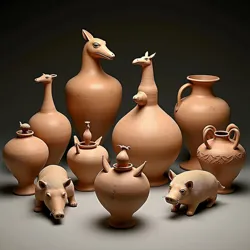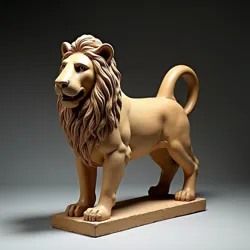Tyrrhenian Zoomorphic Vessels
 A diverse array of Tyrrhenian zoomorphic vessels displayed at the Museum of Ancient Tyrrhenia, showcasing various animal forms including boars, lions, and birds
A diverse array of Tyrrhenian zoomorphic vessels displayed at the Museum of Ancient Tyrrhenia, showcasing various animal forms including boars, lions, and birdsTyrrhenian zoomorphic vessels represent a distinctive category of Etruscan ceremonial pottery that flourished between the 7th and 5th centuries BC. These sophisticated ceramic containers, shaped to represent various animals, exemplify the technical mastery and religious significance of Pre-Roman Italian craftsmanship. The vessels served both practical and ceremonial functions within Etruscan society, often appearing in ritual contexts and high-status burials throughout the Volterra region and broader Etruscan territories.
Historical Development
The tradition of creating animal-shaped vessels in the Tyrrhenian region emerged during the Orientalizing period of Etruscan art, influenced by cultural exchange through the Mediterranean trading network. Early examples from the 7th century BC show clear stylistic connections to Eastern Mediterranean pottery traditions, particularly those of Rhodes and Cyprus. However, Etruscan craftsmen quickly developed their own distinctive approach to zoomorphic representation, incorporating local artistic conventions and religious symbolism.
The evolution of these vessels coincided with the rise of sophisticated ceramic workshops in major Etruscan centers. Archaeological evidence from the Great Necropolis Excavation has revealed numerous production sites, particularly in coastal regions where access to fine clay deposits and trade routes facilitated their manufacture and distribution. The concentration of workshops in certain areas led to the development of regional styles, with distinct characteristics emerging from different city-states.
Design and Typology
 An expertly crafted lion-shaped vessel exemplifying the naturalistic modeling typical of mature Tyrrhenian zoomorphic style
An expertly crafted lion-shaped vessel exemplifying the naturalistic modeling typical of mature Tyrrhenian zoomorphic styleTyrrhenian zoomorphic vessels encompass a wide range of animal forms, each associated with specific cultural and religious significance in Etruscan society. The most common representations include:
The boar, as exemplified by the famous Boar Vessel, represented strength and wilderness, often associated with the Cult of Selvans. Lions symbolized royal power and divine protection, while birds were connected to divination practices and celestial worship. Bulls, another frequent subject, embodied fertility and sacrificial rites in Underworld Festivals.
The vessels typically incorporated functional elements seamlessly into their zoomorphic designs. Pouring spouts were often integrated into the animals' mouths or beaks, while handles might be formed from stylized tails or wings. This integration of practical and aesthetic elements demonstrates the sophisticated design principles employed by Etruscan artisans.
Manufacturing Techniques
The creation of zoomorphic vessels required exceptional skill in ceramic production. Craftsmen employed the Vetulonian style of modeling, which emphasized naturalistic representation while maintaining vessel functionality. The manufacturing process began with the careful selection and preparation of clay through advanced levigation methods, ensuring optimal plasticity and structural integrity.
Vessels were typically constructed using a combination of wheel-throwing and hand-building techniques. The main body would be thrown on a wheel, while detailed features such as legs, heads, and decorative elements were hand-modeled and attached using slip. The Northern Etruscan school developed particularly sophisticated methods for creating stable joins between different components, as evidenced by surviving examples that have maintained their structural integrity for over two millennia.
Cultural and Religious Significance
Tyrrhenian zoomorphic vessels played crucial roles in both secular and sacred contexts within Etruscan society. Their presence in wealthy tombs suggests their importance as status symbols and their role in funerary ceremonies. The vessels often contained specific liquids used in religious rituals, with different animal forms corresponding to particular ceremonial functions.
Archaeological evidence indicates that these vessels were frequently used in libation ceremonies, where their zoomorphic forms added symbolic weight to the ritual actions. The discovery of wine residues in many specimens, particularly those found in religious contexts, supports theories about their use in sacred drinking ceremonies and offerings to deities.
Conservation and Modern Study
Contemporary archaeological research has benefited greatly from advances in archaeometric dating techniques and materials analysis. Studies of clay composition have helped identify specific production centers and track the distribution networks through which these vessels were traded. The Institute of Pre-Roman Studies has pioneered new methods for analyzing surface treatments and decorative techniques, revealing previously unknown aspects of their manufacture.
Conservation efforts have focused on preserving the unique surface treatments and structural integrity of surviving examples. Modern restoration techniques have allowed for the stabilization of fragile specimens while maintaining their archaeological value for future study. The Special Exhibition of Etruscan Ritual Objects has played a crucial role in promoting public understanding of these artifacts' historical and artistic significance.
See also
- Pre-Roman Italian Artisans
- Etruscan Religious Practices
- Ancient Mediterranean Ceramics
References
Significant research contributions have come from the Journal of Mediterranean Archaeology and various archaeological institutions specializing in Pre-Roman Italian material culture.